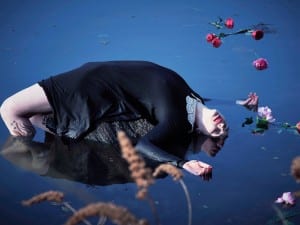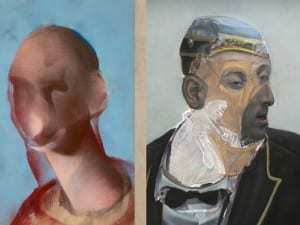Living in today’s world of gratuitous violence, high technology and professionally formulated plans for the future one may not find it surprising that our methods and ideas have historical roots in Fascism. The Guggenheim’s Italian Futurism, 1909–1944: Reconstructing the Universe explores the brutality and brilliance that went into the constantly evolving field of Futurist art whose legacy continues to evolve, and has influenced people like architect Le Corbusier and technologist Steve Jobs.
The exhibition is held along the Museum’s continuous ramp. At the top is Benedetta’s (Benedetta Cappa Marinetti) five paneled canvas, in tempera and encaustic with grand proportions. Within the exhibition it is foremost in painterly elegance and perspective, as well as cognition of the pathways for future communications and their convergence. Take the lift, and start Italian Futurism there.
The show is an encyclopedia of the artists and movements that created the manifestos, plans, film, theater and art works which would symbolically and philosophically represent the ideals of a generation frustrated with sluggish traditions and eager for a future cleansed of an increasingly unbecoming and irrelevant past. As the movement evolved it could not escape its paradoxes — ideological distaste for the female with a powerful lineage of female Futurists, irreverence for the past and an obvious and necessary reliance on the ancient patterns of geometry and purified form of the Classical Greek and Roman traditions. The art however, did not suffer for the paradox, rather the paradox rendered it a complex and vibrant challenge to possibility. This drive for the authentically new, that is nonetheless self-reflexively an eternal hybrid, is the root of what we may call modernity.
The artists used pictorial techniques unusual if not revolutionary at the time and place they were implemented, like biometric abstraction, arte cosmica, arte meccanica and aeropittura, envisaging through new vistas available to human perception through flight, engineering innovation and scientific discovery. The art within the exhibition has obviously set the style for modern models of visual communication and modes of semiotic understanding. As such, the collection of Futurist works allude o the the past and function as both a repository of what will be the future as well as the future itself. Paintings like Virgilio Marchi’s Fantastic City and Building Seen from a Veering Air-plane are as examples of today’s space colony architecture and three dimensional action film scenes.
The mind and the nexus of physics with the unknown are also exemplified within the Italian Futurist tradition, perhaps due to the protagonists obsession with death and violence as a means of arriving at the truth. Two of Fortunato Depero’s 1917 charcoal on paper drawings are titled Mystical Silence and Magical Doorway. Each stylistically anticipates Surrealism with Cubist geometric renderings of human form, passage- and stairways clearly serving as metaphors for mindscape. Giacomo Balla’s Radial Iridescent Interpenetration (Prismatic Vibrations) and Gino Severini’s Spherical Expansion of Light (Centripetal and Centrifugal) are just two of the explorations of light as a live, communicating entity within the exhibition. Also, the 1911 photographs of Anton Giulio Bragaglia show an obvious interest in the physics of simultaneity.
Italian Futurism is deep as well as broad and requires several hours or repeat visits. The universe that is reconstructed is the one we are living in today. It is a comprehensive exhibition of the modern aesthetic and a must see for those who appreciate the details of historical context within contemporary society.
Odette Gregory
Italian Futurism, 1909–1944: Reconstructing the Universe, until 1 September, Guggenheim Museum, 1071 Fifth Avenue, New York, NY 10128
Please see www.guggenheim.org for more information.
Credit:
1. Umberto Boccioni, The City Rises (La città che sale), 1910–11 (detail) Courtesy of The Guggenheim.





